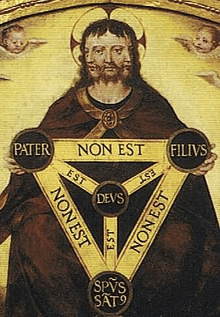
Most who believe in the Trinity are unaware that the idea of a triune god did not originate with Christianity. Much to the contrary, it was the Pagans who founded this idea in the first century, three hundred years before the Trinity became a Christian concept, and they continue that belief today: “In common Neopagan usage, the Triple Goddess is viewed as a triunity of three distinct aspects or figures united in one being. These three figures are often described as the Maiden, the Mother, and the Crone, each of which symbolizes both a separate stage in the female life cycle and a phase of the Moon, and often rules one of the realms of heavens, earth, and underworld. In various forms of Wicca, her masculine consort is the Horned God” (https://en.wikipedia.org/wiki/Triple_Goddess_(Neopaganism) ). Although the Pagan moon goddess today has evolved into Maiden, Mother, and Crone, she was originally known as Hecate, and is credited with being the original triple moon goddess. Wiccan writings dating back to the first century describe her as a “three-fold goddess.” She was also known as Diana in Rome and was featured on a Roman denarius from the first century BC: her face on the front and appearing as three goddesses on the back.


Although the Trinity originated with the Pagans, it was not just Christians who ran with the idea. Several triple gods and goddesses were formed around the same time. For example, in ancient Indian Hinduism, the Tridevi (today, called the Trimurti) was composed of three goddesses in one, with one of those goddesses being triple, as well. Likewise, many of the Celtic gods and goddesses were triune in nature, such as Brighid, who ruled over healing, poetry, and smithcraft. The number three held special meaning for the Celts, as was witnessed in both their literature and religion. Even goddesses who were not thought to be triune in nature sometimes had triplicate aspects to them, such as Hera, who was worshiped as a girl, woman, and widow.

False gods and false views of gods were found everywhere in the ancient world, and these views undoubtedly influenced the views of those making decisions at the council of Nicea, where scholars of the time debated the relationship between the Father, the Son, and the Holy Spirit. The main debate at the council was between a priest, Arius, and a Deacon, Athanasius. Arius fought against the Trinity, whereas Athanasius fought for it. This council was headed by Roman Emperor Constantine, who was not baptized until his deathbed, and was in fact, a sun worshipper. He is even known to have had his wife and son murdered the year after this council took place, proof that his spiritual state was not where it should have been to be heading church affairs. As a result of this council that took place 300 years after Christ died, the Trinity was adopted as the official view of the Catholic Church.
This combining of church and state went on for many centuries (it started with Rome and continued with England) and anyone who opposed the Trinity doctrine did not have the privilege of being called a church, they were considered lunatics, and were often put to death. This forced the true church into hiding. Additionally, the common people did not have access to read the Bible, as it was often not even in their own language. These things perpetuated the false doctrine of the Trinity. It was not until America and freedom of religion were well established that the common people finally had a copy of the Bible in their own language to read in their home. This triggered a revival and the true church resurfaced freely in the mid to late 1800s, at which point, multiple churches rose up to speak against the Trinity.
It is well documented in the New Testament that there was already false doctrine being spread, even in the church, during Paul’s time (2 Corinthians 11:4, Galatians 1:6-9, etc.). For many, it is hard to understand how such a prominent doctrine in the church could be wrong, but we have to understand that is how it has always been. The Jews are known for killing the prophets, who tried to bring them the truth, since the beginning (Matthew 23:37). The Pharisees were the leaders of the mainstream church when Jesus lived on Earth, and he repeatedly called them hypocrites and accused them of putting the doctrines of men before the doctrine of God (Isaiah 29:13, Matthew 15:9, Matthew 23:1-36). Rather than listen to him, they mocked and brutally murdered the Messiah, who is the way, the truth, and the life (John 14:6). The Catholic Church was not only the mainstream church for centuries, it was the only legal option, and with the power of the state, it murdered countless true Christians who tried to defend God’s truth. Jesus warned against this type of deception (Matthew 24:4-5), and we would be wise to heed his words rather than the words of today’s mainstream church, which preaches a doctrine of men that came 300 years after the death of Christ. Jesus taught that the Father was the only God and that He was greater than himself (John 14:28, Mark 12:28-34). Jesus never taught the Trinity and the Trinity is found nowhere in the Bible. It is simply another doctrine of men that brings confusion and tries to separate us from God.
